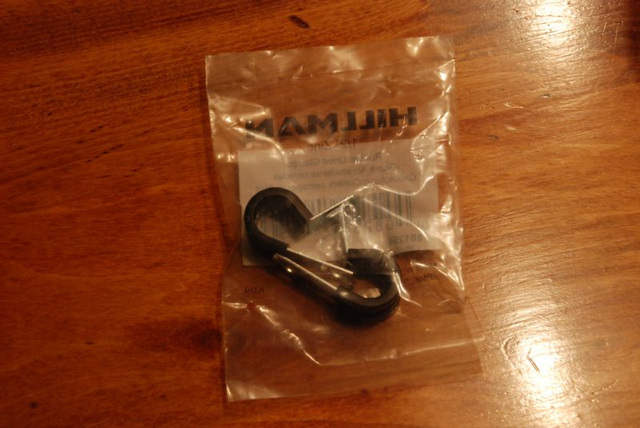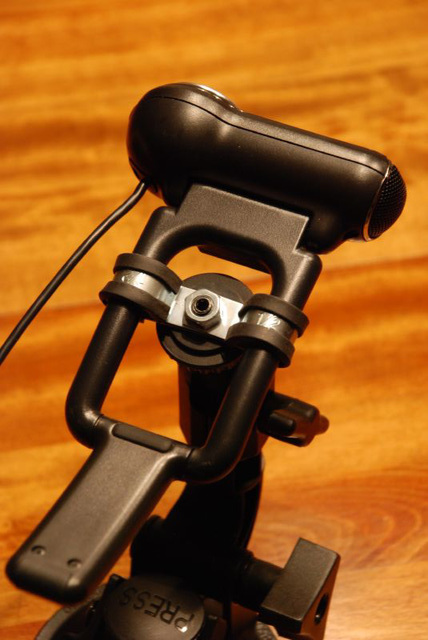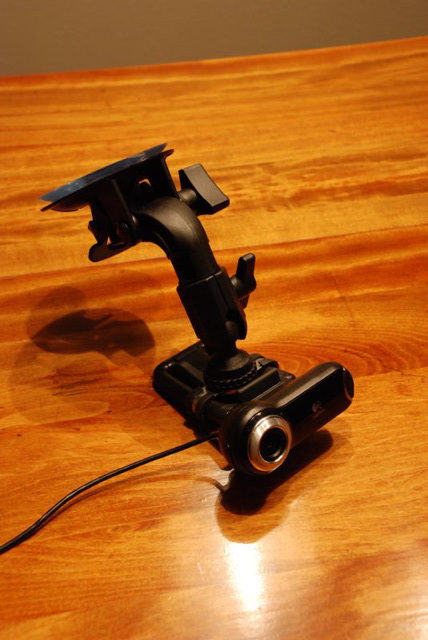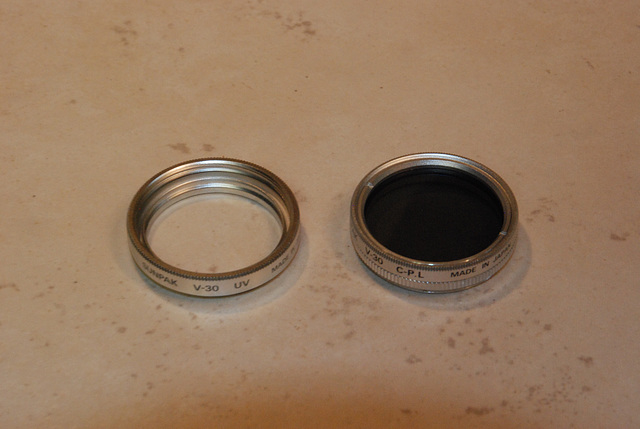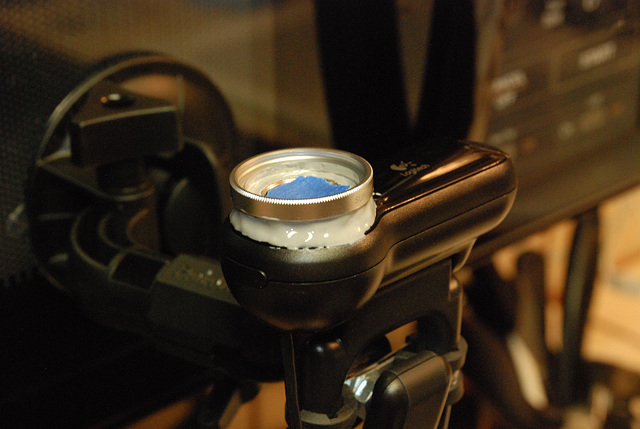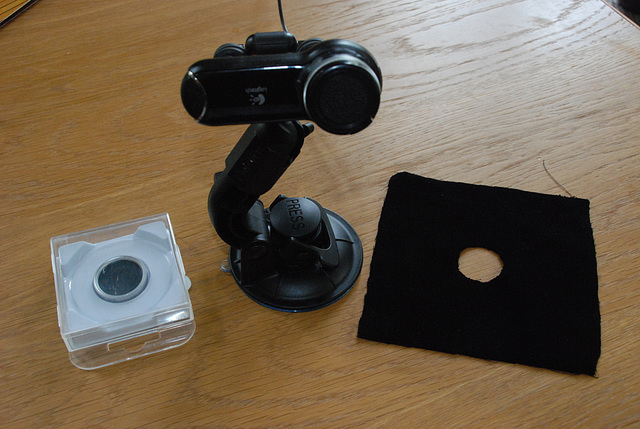
2010 Windshield Webcam Mount
Modifying (hardly at all!) a Logitech 9000 Pro webcam for use in making time-lapse videos on road trips. In this example the webcam is attached to a suction-cup window mount, but the same approach would work in attaching it to a quick-release shoe. The only problem being...well...you don't want to take it off the thread once you get it assembled.
11 Feb 2010
The Hardware
Two 1/2"-diameter P-clamps. Not shown: a single 1/4-20 steel nut. That's it. All told, about $3 worth of materials from the specialty fastener drawers at Lowe's.
Oh, and a Logitech 9000 camera, which was about $85 when I bought it new a year or so ago.
11 Feb 2010
Installed
The webcam as seen from underneath, attached (sorta permanently) to the mounting bracket.
I say "sorta permanently" only because, once you have it assembled, you won't want to take it apart again. For use on a tripod, I would buy a sacrificial quick shoe for the purpose.
And yes, the camera head is upside down on its original mount. I disassembled it to see where I might pot in a threaded insert for the tripod mount, and then put it back together the wrong way. This same mounting approach should work with the original mount in its proper orientation, though.
View the resulting timelapses here.
11 Feb 2010
Installed (Closeup)
It took a lot of bending and adjusting to get the holes in the interleaved feet of the P-clamps to line up. Be patient, and carefully adjust the bends in the "tangential" feet, so as to shift the loop a bit and give a little slack to the "bent" feet on the clamps.
I did most of the adjustments with the tangential feet (only) bolted together with a short 1/4-20 bolt-nut pair. Once the bent feet were adjusted enough, their slotted holes started to fit over the free threads on the bolt.
At that point I removed the bolt and nut, and trimmed a 3/8" section of the rubber liner off of the P-clamps (not visible here - it's in the area facing the "outboard" sides of the camera's original mount) to allow the bent feet to reach just a little bit further (with the untouched rubber liner plenty enough to hold the camera tightly).
Having previously removed the head from the suction mount (by opening the clamp on the ball head), I then slipped the feet of the P-clamps over the thread on the head, and (somehow, don't ask me how) managed to get the nut to engage before it all fell apart. On the suction mount's head, there is exactly enough length to go through the nut and leave the rule-of-thumb 1-2 free threads on the other side.
The only thing left to do is to fit in some sort of restraint on the hinge between the camera and its original mount, so that it can't swivel freely there.
View the resulting timelapses here.
11 Feb 2010
Proper Orientation
A closeup view of the mounted camera in its intended orientation. Since software settings will readily flip the image on this webcam, there's no reason it can't be flipped over the other way.
The original mount on the camera is opened up just for visibility - that little counterweight leg folds down neatly over the steel nut. Unfortunately, however, I couldn't disassemble that part of the original mount in order to take the counterweight off.
View the resulting timelapses here.
11 Feb 2010
Ready to Go
The finished product, ready to be installed in the car.
All told, it took about an hour to fumble around and get this to go together.
View the resulting timelapses here.
25 Jun 2010
Filter Ring and Circular Polarizer
I bought two filters, a decent CP and a cheap UV -- both of which had to be ordered online, since suddenly none of the electronics or camera stores in Denver carry 30mm filters. This is apparently a recent development, as I swear I saw them in stores as recently as a couple months ago when I started planning this project.
The glass in the UV filter was not desired, so I applied masking tape over the whole thing, stood it on a stack of quarters (so that the glass was in contact with the quarters and the ring was unsupported - so as not to put any load on the ring that might distort it), and broke the glass out with a hammer and nail set. The glass crushed into a mess of dust and sand-sized particles (which I did not expect), but came out as clean and easy as I could have hoped for, with no damage or distortion to the ring.
View the resulting timelapses here.
25 Jun 2010
Tack Welds
The filter ring fit over the spherical trim ring around the lens, and so was somewhat self aligning although it did want to slide a bit. Lacking any solid reference features, I aligned it parallel to the face of the lens as best I could by eyeball, then applied a few drops of cyanoacrilite glue to lock it into place for the epoxy.
And yes, the rig is mounted to the front of my microwave.
View the resulting timelapses here.
25 Jun 2010
The Joy of Epoxy
After application of an internal and external fillet of Loc-Tite 50-minute marine epoxy, using a bamboo skewer for mixing and application.
Note the blue tape used to protect the lens from contamination.
View the resulting timelapses here.
27 Jun 2010
The Completed Webcam Rig
The circular polarizer filter (30mm), the webcam with filter ring attached and lens cap in place, and a patch of velvet for a sun shade.
I was a little peeved that the lens cap does not fit the circular polarizer (no outer thread on the filter). Now I have to carry the filter separately in my bag.
Total weight: 1 lb for the camera rig, lens cap, and sunshade, 2 oz for the polarizer and case, and about half an ounce for the cloth bag the folded up rig slips into for carrying.
View the resulting timelapses here.
Jump to top
RSS feed- Latest items - Subscribe to the latest items added to this album
- ipernity © 2007-2025
- Help & Contact
|
Club news
|
About ipernity
|
History |
ipernity Club & Prices |
Guide of good conduct
Donate | Group guidelines | Privacy policy | Terms of use | Statutes | In memoria -
Facebook
X

